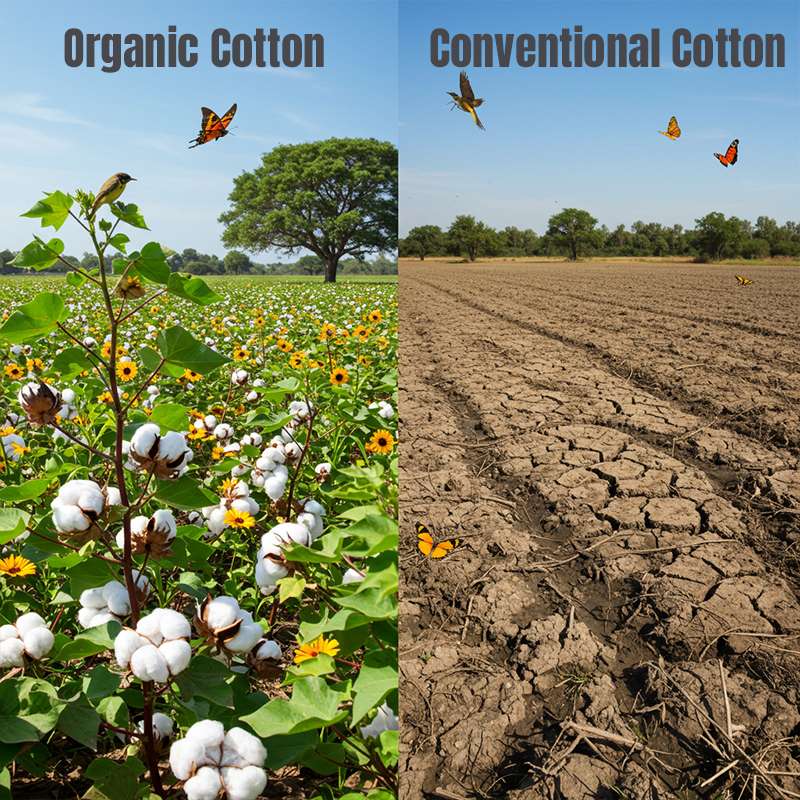Cotton is one of the most widely used fabrics in the world, found in everything from clothing and bedding to home décor. However, not all cotton is created equal. If you’ve ever wondered about the difference between organic cotton and conventional cotton, you’re not alone. While both materials may look and feel similar, their production processes, environmental impacts, and overall benefits differ significantly. This guide explores everything you need to know about organic cotton versus conventional cotton so you can make informed decisions when shopping for cotton-based products.
Understanding Organic Cotton and Conventional Cotton

Before diving into the differences, it’s important to define what organic cotton and conventional cotton actually are.
- Organic Cotton is grown without synthetic pesticides, herbicides, or genetically modified organisms (GMOs). Farmers rely on natural methods, such as crop rotation and composting, to maintain soil health and manage pests. The goal is to produce cotton in an environmentally responsible way while ensuring better working conditions for farmers.
- Conventional Cotton, on the other hand, is typically grown using synthetic fertilizers, pesticides, and genetically modified seeds. It is designed for maximum yield and efficiency, but often at the cost of environmental and human health.
Both types of cotton are used to make clothing, bed sheets, towels, and other textiles, but their differences go beyond just the farming process.
Environmental Impact
One of the most significant distinctions between organic and conventional cotton is their impact on the environment.
Water Usage

- Organic cotton generally requires less water compared to conventional cotton. Because organic farming practices prioritize soil health, the soil retains more moisture, reducing the need for irrigation.
- Conventional cotton is known as one of the most water-intensive crops. It takes approximately 2,700 liters of water to produce a single conventional cotton T-shirt. In areas where water is scarce, this can contribute to serious environmental issues.
Chemical Usage

- Organic cotton is grown without synthetic pesticides, fertilizers, or herbicides. This reduces chemical runoff into water sources and minimizes soil degradation.
- Conventional cotton is often referred to as the “dirtiest crop” because it accounts for 16% of the world’s pesticide use despite only covering 2.5% of the world’s agricultural land. These chemicals can pollute water supplies and harm biodiversity.
Soil Health and Biodiversity

- Organic cotton farming promotes biodiversity by avoiding harmful chemicals and using natural pest control methods. Healthy soil also improves carbon sequestration, helping reduce greenhouse gases.
- Conventional cotton farming depletes soil nutrients due to the repeated use of synthetic fertilizers. Over time, this leads to soil degradation, requiring more fertilizers and water to maintain productivity.
Impact on Human Health
Both farmers and consumers are affected by the way cotton is grown and processed.
Farmers and Workers

- Organic cotton farming eliminates exposure to toxic chemicals, creating safer working conditions for farmers and field workers.
- Conventional cotton farmers are regularly exposed to pesticides and insecticides, which have been linked to serious health issues, including respiratory problems, skin conditions, and even cancer.
Consumers

- Organic cotton products are often free from chemical residues, making them a safer choice for people with sensitive skin or allergies.
- Conventional cotton fabrics may retain pesticide residues, and if they undergo chemical-heavy processing (such as dyeing and finishing), they could release harmful substances over time.
Production Costs and Price Differences

A common concern for consumers is the price difference between organic and conventional cotton.
- Organic cotton is generally more expensive due to the lower yield, labor-intensive farming methods, and the costs associated with certification from organizations such as GOTS (Global Organic Textile Standard) or OEKO-TEX.
- Conventional cotton benefits from large-scale industrial farming, resulting in higher yields and lower production costs. However, these savings often come at an environmental and ethical cost.
While organic cotton products may have a higher price tag, many consumers are willing to pay more for sustainable and ethically produced textiles.
Certifications and Standards
If you’re looking to purchase organic cotton, certifications can help ensure you’re getting a genuine organic product.
- GOTS (Global Organic Textile Standard) – One of the most recognized organic cotton certifications, covering both environmental and social standards in production.
- OEKO-TEX Standard 100 – Tests for harmful substances in textiles, ensuring products are safe for human use.
- USDA Organic – A certification for agricultural products, ensuring they meet organic farming standards.
- Fair Trade Certified – Ensures ethical treatment of farmers and workers involved in cotton production.

These certifications help verify that the cotton used in clothing and textiles is genuinely organic and produced under ethical conditions.
Durability and Comfort

Consumers often wonder if organic cotton is as durable as conventional cotton.
- Organic cotton is typically softer and more breathable because it isn’t treated with harsh chemicals during processing. The fibers maintain their natural structure, making them more comfortable to wear.
- Conventional cotton may feel similar, but over time, exposure to chemicals can weaken fibers, leading to reduced longevity in fabrics.
While both types of cotton are durable, organic cotton often lasts longer because it retains its natural strength without chemical interference.
Ethical and Social Considerations

Ethical fashion is becoming more important to consumers who want to support sustainable and fair labor practices.
- Organic cotton production is often tied to fair labor practices, ensuring better wages and working conditions for farmers.
- Conventional cotton is sometimes associated with exploitative labor practices, including child labor and poor working conditions in some regions.
By choosing organic cotton, you’re not only making an environmentally friendly choice but also supporting ethical labor standards.
Which One Should You Choose?

The decision between organic and conventional cotton depends on your priorities.
- If sustainability and environmental impact are important to you, organic cotton is the clear winner. It uses fewer resources, avoids harmful chemicals, and promotes biodiversity.
- If affordability is your main concern, conventional cotton is often cheaper, but it comes with hidden environmental and social costs.
- If skin sensitivity or allergies are a concern, organic cotton is a better choice because it’s free from chemical residues.
Ultimately, making the switch to organic cotton when possible can help create a more sustainable and ethical fashion industry.
Conclusion
The debate between organic cotton and conventional cotton highlights the trade-offs between cost, sustainability, and ethical considerations. While conventional cotton dominates the market due to its affordability and high yield, the long-term consequences on the environment, human health, and labor conditions make organic cotton a compelling alternative.
By understanding the real differences between these two types of cotton, consumers can make more informed choices that align with their values. Whether you’re buying clothing, bedding, or home textiles, opting for organic cotton can be a small yet impactful step toward a more sustainable future.
| Factor | Organic Cotton | Conventional Cotton |
|---|---|---|
| Farming Methods | No synthetic chemicals, no GMOs | Uses pesticides, herbicides, and GMOs |
| Water Usage | Requires less water | High water consumption |
| Chemical Usage | No synthetic pesticides or fertilizers | Heavy use of chemicals |
| Soil Health | Improves soil fertility | Causes soil degradation |
| Farmer Safety | Safer working conditions | Exposure to toxic chemicals |
| Consumer Safety | Chemical-free, good for sensitive skin | May contain chemical residues |
| Durability & Comfort | Softer, breathable, longer-lasting | Weakened by chemical treatments |
| Price | More expensive | More affordable |
| Certifications | GOTS, OEKO-TEX, Fair Trade | Often lacks certifications |
| Ethical Impact | Supports fair wages and labor rights | May involve exploitative labor |
| Environmental Impact | Eco-friendly, reduces pollution | High environmental damage |

